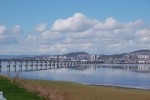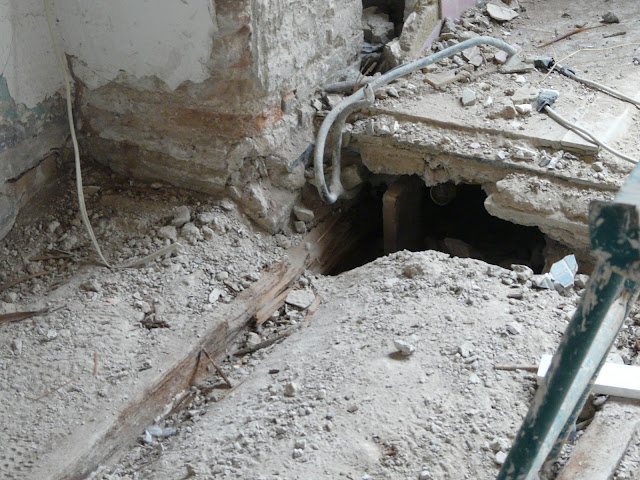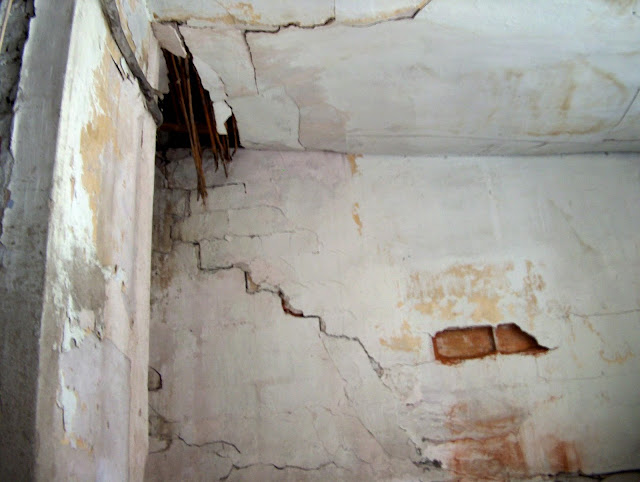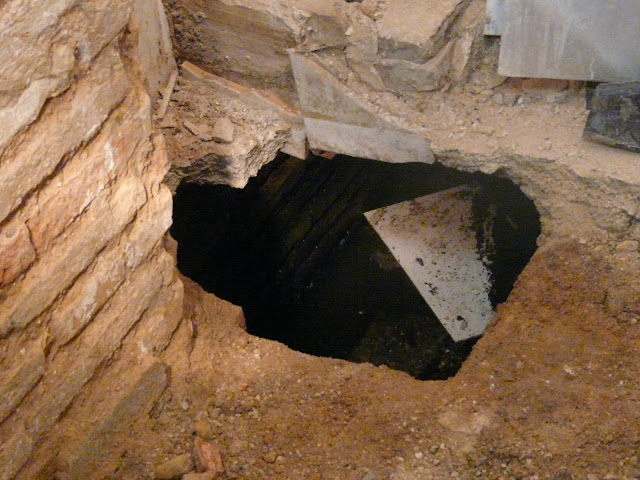I’ve captured this project and building. I believe is a interesting fine project
ShowCase is an on-going feature series on Archinect, presenting exciting new work from designers representing all creative fields and all geographies.

Eren les dotze del matí i a casa de Jack Smith el telèfon no parava de sonar, fins que es decidí a agafar-lo, era l’inspector Arnold.
– sí? – respongué Jack amb una veu adormida.
– Jack tens un cas per resoldre, aquest serà el teu primer cas, és un simple robatori però… per quelcom es comença. Ah, per cert estaves dormint?
– Mm… no – negà no molt convençut.
– Ens vegem en mitja hora al museu Ampelmann – informà l’ inspector al detectiu.
– D’acord –exclamà molt entusiasmat, però encara una mica adormit.
si voleu continuar llegint passeu al”Vull llegir més….”
Jack de seguida es dutxà, i es vestí molt elegant amb els seus mitjons de la sort, ja que per a ell, aquest era un dia molt important, tot el que havia estudiat durant molts anys, ara ho posaria en pràctica, i demostraria el que val.
Jack de seguida arribà.
– Hola inspector Arnold, conta’m que és el que ha passat.
– Bon dia jack, el lladre ha entrat al museu, ha agafat el quadre, lògicament han saltat les alarmes, i immediatament han tancat les portes. Des d’aleshores no ha ha eixit cap de les persones que hi eren quan ha ocorregut l’insident, el lladre no ha pogut eixir, de forma que el lladre es troba entre les persones d’allí dins. A per cert, he ordenat que també vingués George Shelley perquè t’ajude una mica.-explicà l’inspector.
– I les càmeres de seguretat no han gravat res? –s’interesà Jack .
– No, es veu que un noi entre uns onze i tretze anys anys, ha apegat un xiclet a la càmera, i els guàrdies de seguretat no s’han adonat.
– I per què ho ha fet? Encara es troba al museu?
– No, l’ha col·locat i se n’ha anar, ho ha fet un quart d’hora abans que saltaren les alarmes. – respongué l’inspector.
Jack entrà al museu, i el primer que feu, fou inspeccionar el museu, va enregistrar tots els racons del museu, fins que pensà que als banys seria molt probable que hagués alguna pista. Hi havia quatre banys, dos situats a la segona planta i dos més a la cafeteria.
– Anem al del segon pis, ja que estem al tercer. – exclamà l’ajudant d’en Jack.
Entraren al bany de les dones, però no hi havia cap irregularitat, però quan volgueren entrar al dels homes, la cosa es complicà, era tancada, probablement el lladre o el quadre es trobaven entre aquelles quatre parets, a més, s’escoltava una petita font, que no parava de tirar aigua, el detectiu Smith, informà a l’ inspector del succés, i aquest manà als policies que l’obriren ells, per si el lladre encara es trobava allí, podria tindre una arma. Els policies entraren, i miraren per tots els racons per vore si s’havia amagat, però no fou així, els policies donaren l’ordre que ja podien entrar, i que no hi havia ningú, el detectiu entrà molt impacient, però no trobà res, hi havia una finestra al fons, era bastant petita d’uns trenta centímetres quadrats, era difícil que per allí hagués eixit algú amb un quadre a les mans.
– Quant mesura el quadre? – preguntà George.
– Fa cinquanta-dos coma seixanta-cinc per trenta-u amb quaranta-sis centímetres, el quadre no pot haver passat per la finestra – afirmà un guia del museu.
– Ja, però si retirem el marc, i enrotllem el quadre si que pot passar – exclamà el detectiu amb seguretat.
Després d’una pausa:
– I aleshores com s’ho ha fet per tancar la porta? – preguntà l’ajudant el detectiu Smith, George.
La pregunta es quedà en l’aire ja que ningú va saber respondre-la.
Jack mirà un poc més aquelles parets i aquell sòl, on només trobà unes restes de cigarretsal terra, que podien ser, o no del lladre, i se’n anà als banys de la cafeteria.
El detectiu entrà al bany dels homes però en no veure quelcom quelcom irregular eixí,
Decidí entrar al bany de les dones, tot i que estava fora de servei. Va fer una ullada, i es va quedar aterrit, i molt esglaiat en veure una treballadora del museu morta, havia rebut un fort colp al cap, amb uns pals de fusta, segurament els trossos del marc, del quadre que es volia robar, la imatge era molt aterridora, la noia estesa, sentada i desangrada a la tapa del wàter, i als seus peus uns trossos de fusta tacats de sang. Era molt estrany, la posició en què estava el cos era molt estranya, estava col·locada de forma que la mà esquerra subjectara la cadena, i l’aigua no parava d’eixir, Jack de seguida avisà el seu superior. Aquest cas ja no era un simple robatori. Com que estava el cos al bany de les noies, l’assassí devia de ser una dona? Com és que la dona es trobava al bany, si es trobava fora de servei? Probablement l’assassí era algú que hi treballés allí, o algú que tinguera un fàcil accés a les claus, per poder obrir la porta del bany? Tot era molt complicat, el detectiu cada vegada ho via tot més fosc.
Després d’una estona arribà George per a informar-lo.
– Detectiu Jack! Dels cinquanta-tres sospitosos, el nombre s’ha reduït molt, els principals sospitosos tan sols són nou persones!
– Sí? Ara mateixa volia anar a fer-los unes quantes preguntes – s’alegrà Jack.
– Els principals sospitosos són: una professora de plàstica, anomenada Marina Estruch, d’uns quaranta anys aproximadament, un matrimoni jubilat d’uns seixanta anys, un mestre de pintura, en Peter Sullivan, un matrimoni, la dona és pintora i professora d’art abstracte, i el marit pintor neoimpressionista, un grup de tres homes, un arquitecte, altre aparellador i l’altre té una fàbrica tèxtil tots al voltant dels cinquanta anys, i la netejadora, Mary Brines.
El detectiu arribà a la sala on els principals sospitosos esperaven ja des de feia una bona estona, a anar-se’n.
– Hola, bona vesprada, sóc el detectiu Smith – es presentà Jack – ara vos faré a cada un unes quantes preguntes – informà als sospitosos – vinga amb mi senyora…
– Marina, Marina Estruch.
– D’acord Marina.
Se n’anaren a la sala del costat.
– A que es dedica vostè? – preguntà el detectiu.
– Sóc mestra de plàstica, d’institut.
– Per què ha decidit vindre justament avui?
George el va interrompre, de sobte es va sentir a l’altra sala un gran crit d’alegria, era ell, que dia “ja ho `se, ja de descobert qui és l’assassí ” la senyora Estruch i el detectiu entraren ràpidament a l’altra sala.
– L’assassina és la netejadora! Es una dona i a més pot accedir a tots els racons del museu. Pel matí mentre netejava ha vist que a la càmera hi havia apegat un xiclet, i no la desenganxat, a continuació ha agafat el quadre, l’ha posat al carro on duu els productes de netja, i fent com si netejava el bany dels homes, l’ha tret per llevar-li els marcs, llavors ha entrat la guia difunta, i l’ha amenaçat de contar-li a la policia tot el que havia vist, a tu agafant el quadre, i amb el tres de marc que tenies a la mà, li has pegat un cop sec, i s’ha quedat sense coneixement, l’has posada a la teua cistella i te l’has endut als banys de baix, perquè no sospitaren, ja que tu t’encarregues de netejar les dues plantes de dalt, llavors has tancat la porta del bany de dalt dels homes, per entrevindre’ns, i mentrestant netejar les restes i proves que t’incriminaven. –explicà George.
– Això és mentida, jo no ho he fet, per què voldria jo robar aquest quadre?
– Està molt clar, a les netejadores vos paguen molt poc, i necessitaves diners… i aquest era el camí més fàcil. No et resisteixis, les proves han d’estar en alguna d’aquestes papereres, confessa.
Tot encaixava, però tot i això jack no estava convençut, hi havia certes coses que no li acabaven de convèncer. Va estar reflexionant durant una estona sobre el cas, pensant en altres possibilitats, de sobte se ‘n va eixir de la sala corrent cap al bany dels homes de la segona planta, mentrestant els policies estaven escorcollant totes les paperes del museu. Després d’una estona el detectiu tornà,
– Ara tot encaixa! Si la meua deducció és correcta, la senyoreta Mary, la netejadora no és la culpable.
– I doncs qui és? És la que ho ha tingut més fàcil. – exclamà l’ajudant de Jack.
– La persona responsable de l’intent de robatori i de l’assassinat de la treballadora del museu és vostè senyor Peter Sullivan! Vostè ja ho tenia tot planejat, un dependent del taulell m’ha informat que en l’últim mes ha vingut quatre voltes a veure aquesta mateixa exposició. Tot ha començat aquest matí, ha estat pels voltants del museu, i ha vist un noi amb un xiclet, i li ha promès que si entrava i l’apegava a aquella càmera de seguretat, li donaria, no sé… diners potser, és a dir una recompensa, el noi ha acceptat, llavors vostè ha entrat, i quan ha vist que era el moment oportú, l’ha agafat, l’ha amagat en el maletí que de, i se’n ha anat al bany de la cafeteria, i ha entrat al bany de les dones, o bé perquè el d’homes estava ocupat o per a despistar-nos, ha començat a desmuntar el quadre per poder amagar-se’l millor i poder dissimular el petit bony que li provocaven els marcs, llavors ha arribat una dona, i l’ha vist amb les “les mans en la massa”, i l’única sortida que tenia era assassinar-la, i ha aprofitat els pals de fusta del marc, a continuació ha amagat el quadre en alguna part del bany, ha anat a ràpidament per a agafar el cartell de fora de servei, ja que en realitat, el que estava fora de servei era el dels homes de la segona planta, per això era tancat, i per si no us n’havíeu adonat, se sentia un soroll molt estrany, ja posat el cartell a la porta, i mentrestant, ha posat la cadena de manera que no baixara, i no parava de tirar aigua,
aparentava perfectament un bany fora de servei.
Està d’acord amb les meues deduccions senyor Sullivan?
– No, és clar que no! Quina bajanada s’ha inventat ?
– No es resisteixca, hem trobat un guants a la paperera, i allí estaran les seues.
Txell Blesa

We are going in final work process……..fast, fast, quickly….. !
Three volums interact among them.
Auditorium more theatre and one small concert room.
Three underground floors for parking.
We still need to design the ground.
We have a lot of gradient between streets for a good planning.
It’s very difficult to get it !
Here the slider in the middle of process.


You can clean your monitor going at video.
For to watch it you must brushing to “I want read it more….”
You would also can watch it on PPS more slowly when you go at lower file link (archive). But….invoiced.
Best wishes
PS: photo isn’t a ghost. There is only a nearly take of Meritxell’s nose !
If you want to keep on reading and seeing about this experience just click on “Vull llegir la resta…”

11 January, 2010
An international architectural competition has been launched to design a landmark building for the Victoria & Albert Museum in Dundee.
The £47 million project – a centre for 21st century design in partnership with Dundee University – is part of a regeneration scheme for the city’s waterfront. The site for the new building will extend out into the River Tay.
“We want to find a design team that can deliver a world class building fitting for such a high quality project,” said Mike Galloway, director of city development for Dundee City Council, which is backing the project.
“A two-stage architectural competition is about to be launched and we expect to have interest in this project from prominent architects and designers from around the world.”
The V&A at Dundee is due to open in 2014, hosting a range of exhibitions and events with some of the content provided by the V&A. Funding will come from the Scottish Government, other public bodies and private donations.
scotland’s culture minister Fiona Hyslop said: “The V&A at Dundee will boost the city’s – and Scotland’s – reputation as a thriving centre for the creative industries.
“The Scottish government has put on record its strong support for this exciting project, so I am pleased to see the partnership making good progress.
“I look forward to seeing many innovative and high-quality designs coming forward.”
V&A director Mark Jones said: “The creation of the V&A at Dundee fulfils the V&A’s aim of sharing its collections, exhibitions, skills and resources, reaching new audiences and giving access to more people nationally and internationally.”
A feasibility study on the scheme predicted that the V&A at Dundee would attract 500,000 annual visitors to the city, create up to 900 jobs and add £5.7 million output to the Scottish economy.
Details of the competition will be published in the Official Journal of the European Union (Ojeu).
Read more: http://www.bdonline.co.uk/story.asp?sectioncode=426&storycode=3156074&channel=783&c=1#ixzz0cnJeehxW
We shall maybe can to show one proposal there it. The Dundee Council is thinking in great architect teams. But to those will be as amazing opportunities as to the little teams to bet competing (own cas), when there is long time ahead…..
The Scottish city Dùn Dèagh (Dundee in English) seems a society wants beating up. It haven’t a waterfront well resolved, fault of communitarian infrastructures, etc. like València, Palma or Barcelona twenty five years ago. We have a good know how in that stuff. The river is very big. There are very much a only one politic actions to recuperate urbanism history than that operation.
I’ve captured this project and building. I believe is a interesting fine project
ShowCase is an on-going feature series on Archinect, presenting exciting new work from designers representing all creative fields and all geographies.
Describe the client and the program.
We build this house for ourselves, Britt Crepain & Stefan Spaens (previously CSO ontwerpers, currently CSD Architecten)
How does the design respond to the context?
A very small plot of land (4x15m / built 4×12.5m) in a narrow street in the Center of Antwerp, rear facade facing south. The design responds by opening up both facades to the maximum, split-levels and a void with a roof of glass on top. 3 levels house the main living areas bureau/library/kitchen/dining, and the highest split-level is the sitting room with open fire and views of the city and the sky. From there, you can access the roof-terrace (also split-leveled) with views over the entire city.
In total, the house has a basement, ground floor and 4 levels. The split-levels bring the light from the south through the house. A lot more than with a normal (or standard) racking of floors that most houses have. Sunlight comes through everywhere, especially in wintertime when the sun is low (ecologically, we benefit from a south facade in winter, in summer we can open op top windows and create a natural ventilation through the void and the opening to the roof-terrace. Currently it’s snowing, and the top level is almost like an igloo with the open fire and snow that lays on the glazed inclined windows.
Describe the choice of materials for this project.
We chose all materials as natural as possible, colors flowing into each other, to create an otherwise monolithic character. Inspiration for the color pallet was found on a beach in France (driftwood, pebbles, the color of the sand).
What is the footprint of the house? How many floors?
Footprint: 50 sqm (outer wall), 47 sqm (inner wall). Where split-leveled: front = 27 sqm (void stairs/elevator, 4 levels), rear: 16 sqm ).
Levels: 6 and a half. Level -1: basement/storage; level 0: ground floor = polyvalent for bureau/commercial or as it is now ‘carport’, washing room and extra storage behind a curtain; level 0.5: vestiaire; level 1: front = main bedroom/master bathroom; rear = second bedroom + show room; level 2: front = bureau; rear = hobby + guest room; level 3: front = kitchen; rear = dining; level 4: sitting room around open fire and access to first roof terrace; level 5: main roof terrace
Did you design any of the furniture or fittings for the house?
Britt Crepain designed all the furniture, completely integrated (functional and esthetically) in the architecture that Britt & Stefan both designed. Some of the fittings (for example the glazed doors) are also designed by her. The rest of the fittings are carefully selected.
Is there anything interesting about this project that is not evident in these photos?
The change of the colors by the sunlight that you cannot capture on photo (only on video), the warmth of the house, the igloo, the silence on the top floor and roof terrace, our favorite spots to sit, and the angle of view that you have from there.
In short: the actual and always changing atmosphere (but to capture this, you have to live here for a while).

– The last post told the truth about the issue.
– Now I shall try hard to show VIPs more advanced than this way.
– His vista is an overview of the educational world.
– He has explained his view with a lot of humour and talent.
– The Shakespeare’s joke is great!
😛 What did you think about it?

At universities, we learn very inflexible rules regarding concrete.
I will explain it with a practical example of rehabilitation. This will be in two posts. This is first. In the next I will talk about reinforced concrete directly. Here I have only showed the issue. This has very significant economic repercussions for the building. Those bad practices are caused by unsustainability and a lack knowledge.
++++++++++++++++++++++++++++++++++++++++++++++++++++
Here you will find a photografic Slide.
If you want to keep on reading about this experience just click on “Vull llegir la resta…”
A FOUNDATION REINFORCED IN “PARE JOFRE’ STREET”.
The foundation system for a building –its substructure- is the critical link in the transmission of building loads down to the ground. Bearing directly on the soil, the foundation system must distribute vertical loads so that settlement of a building is anchored to the building’s superstructure against uplifting and racking due to wind or earthquake forces. The most critical factor in determining the foundation system of a building is the type and bearing capacity of the soil to which the building loads are distributed.

The foundation system typically found in old buildings in València consists of columns, piers, or walls –all made in bricks or stones- which rest directly on the soil. The transition elements are the footing. They are spread in order to distribute their loads over a rather wide area that the soil’s bearing capacity is not exceeded.

Therefore, the first step in the rehabilitation was to examine the foundations. We know the fault when we see cracking in the superstructure, such as in piers, beams or walls. We need to dig around that with a lot of difficulty and great care.


Next, we looked on the third floor and we saw a few inclined cracks. They were produced by sliding and overturning in two footings at the foundations. The building was built in 1885. We have dug them to check and process the cause and solution. The footings are by the side of a drainage channel. The old drainage system was made in small brick channels. The dark water discourses into them is organic matter. The dark water had been filtering, for a long time, through the bricks of the channel. In fact, cohesive soils, ground water can also rise and fall through capillary action to remove earth.


To be continued…
I think about this video-clip:
– That’s society reversed in calm.
– The space used in time function. It is slightly jarring, though interesting to note that nobody around her seems to take notice of her admittedly nonconformist behaviour.
– Time practice works on the real time of new technologies, if it wants to or not. The temporary practices leave the historical time, falling on the worldtime.
– So I believe, there are other calmer uses than the ‘perception fields’ suggested by Paul Virilio . It isn’t only the ‘field of battle’. As far back as the oldest conflicts in human history .
– Life time can be compressed and reversed, too. In any order creating different performaces.
03- january-2009
Artist: Hye Yeon Nam.
The winning videos in the Metropolis Art Prize 2009 will be screened on the giant jumbotron monitors in Times Square, New York, on December 17 2009. The event is open to the public, so if you’re in the area, come along!
To find out more, visit the Art Prize page
Space takes on multiple definitions. For me, I understand space as the sum of cultural and social forces that act on me. Through the space, my body feels all changes around me instantly and intimately. When I move from Korea to the United States, my body became a gauge that felt my displacement and recognized not only the conformity inflicted on me in the United States, but it also allowed me to deconstruct the rule from my hometown that I had taken for granted as normal. In my video piece, I attempt to convey the feeling of displacement and conformity by acting of walking. I perform walking forward and other people seem to be walking backward. However, I was walking backward in the real scene and I made it simply reversed. The space of being neither here following correct rule nor there following incorrect rule is precisely what I try to convey in this video. I finished NYC Time Square version and will make Portugal version next week. It will continue in several cities.
If you want to keep on reading about this experience just click on “Vull llegir la resta…”
Thinking against Paul Virilio: Logistics of perception
In contemporary warfare, logistics does not just imply the movement of personnel, tanks, fuel and so on but also implies the movement of images both to and from the battlefield. Virilio talks a lot about the creation of CNN and the concept of the newshound. The newshound will capture images which will then be sent to CNN, which may then be broadcast to the public. This movement of images can start a conflict (Virilio uses the example of the events following the broadcasting of the Rodney King footage). The logistics of perception also relates to the televising of military maneuvers and the images of conflict that are watched not only by people at home but also by the military personnel involved in the conflict. The ‘field of battle’ also exists as a ‘field of perception’.
We’re trying to find the happiness state.